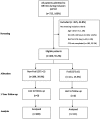The FRAIL-FIT study: Frailty's relationship with adverse-event incidence in the longer term, at one year following intensive care unit treatment - A retrospective observational cohort study
- PMID: 32489408
- PMCID: PMC7238472
- DOI: 10.1177/1751143719838212
The FRAIL-FIT study: Frailty's relationship with adverse-event incidence in the longer term, at one year following intensive care unit treatment - A retrospective observational cohort study
Abstract
Introduction: Frailty is a syndrome of decreased reserve and heightened vulnerability. Frailty scoring has potential to facilitate more informed decisions in the intensive care unit. To validate this, its relationship with outcomes must be tested extensively. This study aimed to investigate frailty's impact on adverse outcomes after intensive care unit admission, primarily one-year mortality.
Methods: This single-centre retrospective observational cohort study examined prospectively collected data from 400 intensive care unit patients. Frailty was assessed using the Clinical Frailty Scale and defined as Clinical Frailty Scale ≥ 5. Unadjusted and adjusted analyses tested the relationships of frailty, covariates and outcomes.
Results: Of 400 eligible patients, 111 (27.8%) were frail and 289 (72.3%) were non-frail. Compared to non-frail patients, frail patients were older (62 vs. 56, p < 0.001) and had higher Acute Physiology and Chronic Health Evaluation II scores (22 vs. 19, p < 0.001). Females were more likely to be frail than males (34.1% vs. 22.9% frail, p = 0.018). Frail patients were less likely to survive the intensive care unit (p = 0.03), hospital (p = 0.003) or to one year (p < 0.001). Frailty significantly increased one-year mortality hazards in unadjusted analyses (hazard ratio 1.96; 95% confidence interval 1.41-2.72; p < 0.001) and covariate adjusted analyses (hazard ratio 1.41; 95% confidence interval 1.00-1.98; p = 0.0497). Frail patients had more hospital admissions (p = 0.014) and longer hospital stays within both one year before (p = 0.002) and one year after intensive care unit admission (p = 0.012).
Conclusions: Frailty was common and associated with greater age, female gender, higher sickness severity and more healthcare use. Frailty was significantly associated with greater risks of mortality in both unadjusted and adjusted analyses. Frailty scoring is a promising tool which could improve decision making in intensive care.
Keywords: Clinical Frailty Scale; frail; intensive care unit; mortality.
© The Intensive Care Society 2019.
Figures



References
-
- Fried LP, Ferrucci L, Darer J, et al. Untangling the concepts of disability, frailty, and comorbidity: implications for improved targeting and care. J Gerontol 2004; 59: M255–M263. - PubMed
-
- Fiatarone MA, O’Neill EF, Ryan ND. Exercise training and nutritional supplementation for physical frailty in very elderly people. N Engl J Med 1994; 330: 1769–1775. - PubMed
-
- Fried LP, Tangen CMW, Newman J, et al. Frailty in older adults: evidence for a phenotype. J Gerontol 2001; 56: 146–156. - PubMed
LinkOut - more resources
Full Text Sources
